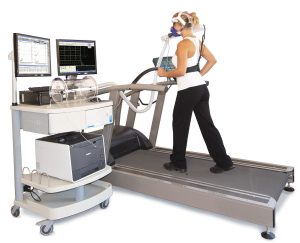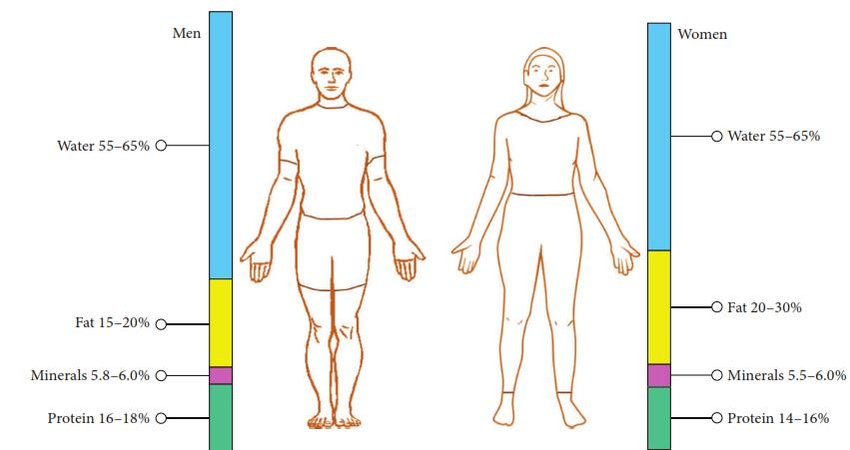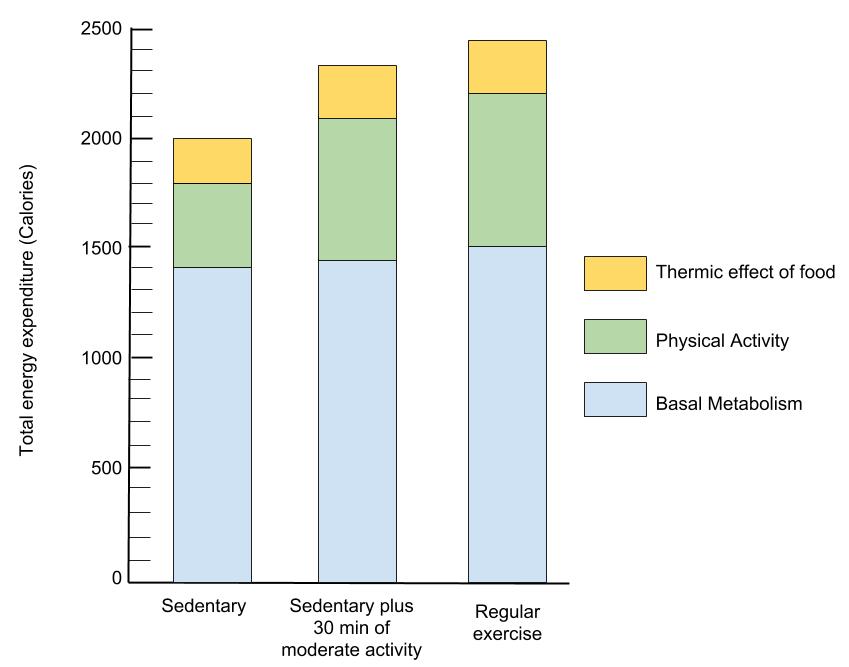The Essential Elements of Physical Fitness
Cardiorespiratory Endurance
Cardiorespiratory endurance is enhanced by aerobic training which involves activities that increase your heart rate and breathing such as walking, jogging, or biking. Building cardiorespiratory endurance through aerobic exercise is an excellent way to maintain a healthy weight. Working on this element of physical fitness also improves your circulatory system. It boosts your ability to supply the body’s cells with oxygen and nutrients, and to remove carbon dioxide and metabolic waste. Aerobic exercise is continuous exercise (lasting more than 2 minutes) that can range from low to high levels of intensity. In addition, aerobic exercise increases heart and breathing rates to meet increased demands for oxygen in working muscles. Regular, moderate aerobic activity, about thirty minutes at a time for five days per week, trains the body to deliver oxygen more efficiently, which strengthens the heart and lungs, and reduces the risk of cardiovascular disease. Strengthening your heart muscle and increasing the blood volume pumped each heartbeat will lead to a lower resting heart rate for healthy individuals.[1] Aerobic exercise increases the ability of muscles to use oxygen for energy metabolism therefore creating ATP.
Aerobic capacity, or VO2 is the most common standard for evaluating cardiorespiratory endurance. VO2 max is your maximal oxygen uptake, and the VO2 max test measures the amount of oxygen (in relation to body weight) that you can use per minute. A test subject usually walks or runs on a treadmill or rides a stationary bicycle while the volume and oxygen content of exhaled air is measured to determine oxygen consumption as exercise intensity increases. At some point, the amount of oxygen consumed no longer increases despite an increase in exercise intensity. This value of oxygen consumption is referred to as VO2 max, ‘V’ meaning volume, and ‘max’ meaning the maximum amount of oxygen (O2) an individual is capable of utilizing. The higher the number, the more oxygen you can consume, and the faster or longer you can walk, run, bike, or swim, among other aerobic activities. VO2 max can increase over time with training.[2]

(Source: Wikimedia Commons, Cosmed, CC-BY-SA)
Muscle Strength
Muscle strength is developed and maintained by weight or resistance training that often is called anaerobic exercise. Anaerobic exercise consists of short duration, high intensity movements that rely on immediately available energy sources and require little or no oxygen during the activity. This type of high intensity training is used to build muscle strength by short, high intensity activities. Building muscle mass is not just crucial for athletes and bodybuilders—building muscle strength and endurance is important for children, seniors, and everyone in between. The support that your muscles provide allows you to work, play, and live more efficiently. Strength training involves the use of resistance machines, resistance bands, free weights, or other tools. However, you do not need to pay for a gym membership or expensive equipment to strengthen your muscles. Homemade weights, such as plastic bottles filled with sand, can work just as well. You can also use your own body weight and do push-ups, leg squats, abdominal crunches, and other exercises to build your muscles. If strength training is performed at least twice a week, it can help to improve muscle strength and to increase bone strength. Strength training can also help you to maintain muscle mass during a weight-loss program.[3]
Muscle-strengthening activity has three components:
• Intensity, or how much weight or force is used relative to how much a person is able to lift;
• Frequency, or how often a person does muscle-strengthening activity; and
• Sets and repetitions, or how many times a person does the muscle-strengthening activity, like lifting a weight or doing a push-up.
The effects of muscle-strengthening activity are limited to the muscles doing the work. It is important to work all the major muscle groups of the body—the legs, hips, back, abdomen, chest, shoulders, and arms.[4]
Flexibility
Flexibility is the range of motion available to your joints. Yoga, tai chi, Pilates, and stretching exercises work to improve this element of fitness. Stretching not only improves your range of motion, it also promotes better posture, and helps you perform activities that can require greater flexibility, such as chores around the house. In addition to working on flexibility, older adults should include balance exercises in their regular routine. Balance tends to deteriorate with age, which can result in falls and fractures.[5]
Body Composition
Body composition is the proportion of fat and fat-free mass (which includes bones, muscles and organs) in your body. A healthy and physically fit individual has a greater proportion of muscle and smaller proportion of fat than an unfit individual of the same weight. Although habitual physical activity can promote a more healthful body composition, other factors like age, gender, genetics, and diet contribute to an individual’s body composition. Women have a higher healthy fat percentage than men. For adult women, a healthy amount of body fat ranges from approximately 20 to 30 percent. Adult males on the other hand range from around 15 to 22 percent of body fat.[6]

(Source: IOP Science, Munawar A. Riyadi et al., CC0)
Metabolic Fitness
Being fit also includes metabolic fitness. It relates to the number of calories you require to survive and the number of calories you burn during physical activity. Recall that metabolism is the sum of all chemical reactions that occur in the human body to conduct life’s processes. Some are catabolic reactions that break down nutrients to supply the body with cellular energy. The rate at which a person burns calories depends on body composition, gender, age, nutritional status, physical activity, and genetics.
Increasing your daily activity and shedding excess body fat helps to improve metabolic fitness. Physical activity also makes weight management easier because it increases energy needs and lean body mass. During moderate to vigorous activity, energy expenditure raises well above the resting rate. With continuous exercise over time, regular exercise increases lean body mass as well. At rest, lean tissues use more energy than fat tissue therefore increasing basal metabolism. The combination of increased energy output, energy expenditure and basal needs over a long period of time can have a major impact on total energy expenditure (see Figure 16.2 “The Effect of Physical Activity on Energy Expenditure”). The more energy you expend, the more foods you are able to consume while maintaining a healthy weight. Any improvement to metabolic fitness is beneficial and means a decrease in the risk for developing diabetes, or other chronic conditions.
One measurement of metabolic fitness is basal metabolic rate, or BMR, which is a measurement of the amount of energy required for the body to maintain its basic functions while at rest; ie breathing, heartbeats, liver, kidney function, and so on. On average, BMR accounts for between 50 and 70 percent of a person’s total daily energy expenditure. Different factors can affect the BMR. For example, a slender person who is tall has more body surface area and therefore has a higher RMR relative to their body mass (weight). Also, muscle utilizes more energy at rest than fat, so a person with more muscle mass has a higher BMR.
A second measurement of metabolic fitness is the number of calories burned during physical activity. The amount of calories burned depends on how much oxygen is delivered to tissues, and how efficiently metabolic reactions consume oxygen and, therefore, expend calories. One of the best estimates of energy expenditure during exercise is how much oxygen a person consumes. Recall that VO2 max is a measure of the maximum cardiorespiratory capacity to deliver oxygen to the body, especially to working muscles during exercise.. Greater VO2 max is indicative of better cardiovascular fitness. In contrast to RMR, VO2 max increases significantly with exercise training due to training adaptations that increase the body’s ability to deliver oxygen to working tissues and an increased capacity of muscles to take up and utilize oxygen.

(Source: University of Hawaii @ Manoa, Allison Calabrese, CC-BY)
Physical Activity Recommendations
The Physical Activity Guidelines for Americans is issued by the U.S. Department of Health and Human Services (HHS).[7] It complements the Dietary Guidelines for Americans, a joint effort of HHS and the U.S. Department of Agriculture (USDA).[8] Together, the two documents provide guidance for the public on the importance of being physically active and eating a healthy diet to promote good health and reduce the risk of chronic diseases. For more detailed information, you can access the full guidelines at the following links (open in new windows):
Physical Activity Guidelines for Americans, 2nd Edition (PDF)
Dietary Guidelines for Americans, 2020-2025 (PDF)
Learning Activities
Technology Note: The second edition of the Human Nutrition Open Educational Resource (OER) textbook features interactive learning activities. These activities are available in the web-based textbook and not available in the downloadable versions (EPUB, Digital PDF, Print_PDF, or Open Document).
Learning activities may be used across various mobile devices, however, for the best user experience it is strongly recommended that users complete these activities using a desktop or laptop computer.
- All About Heart Rate. American Heart Association. https://www.heart.org/en/health-topics/high-blood-pressure/the-facts-about-high-blood-pressure/all-about-heart-rate-pulse. Accessed August 7, 2025. ↵
- Ed Eyestone. Fast Lane: Double Your Endurance. RunnersWorld.com. https://www.runnersworld.com/uk/health/a763285/fast-lane-double-your-endurance/. Published February 25, 2008. Accessed August 7, 2025. ↵
- Navigating the Impact of New Weight Loss Medications. American College of Sports Medicine. https://acsm.org/navigating-the-impact-of-new-weight-loss-medications/. Accessed August 7, 2025. ↵
- U.S. Department of Health and Human Services (2018). Glossary. Physical Activity Guidelines for Americans, 2nd edition. https://odphp.health.gov/sites/default/files/2019-09/Physical_Activity_Guidelines_2nd_edition.pdf. Accessed August 7, 2025. ↵
- Fitness Training: Elements of a Well-Rounded Routine. MayoClinic.com. http://www.mayoclinic.com/health/fitness-training/HQ01305. Accessed August 7, 2025. ↵
- Riyadi, M.A. et al. (2017). Development of Bio-impedance Analyzer (BIA) for Body Fat Calculation. IOP Converence Series Materials Science and Engineering, 190(1): 012018. https://iopscience.iop.org/article/10.1088/1757-899X/190/1/012018. Accessed August 7, 2025 ↵
- U.S. Department of Health and Human Services (2018). Physical Activity Guidelines for Americans, 2nd edition. https://odphp.health.gov/sites/default/files/2019-09/Physical_Activity_Guidelines_2nd_edition.pdf. Accessed August 7, 2025. ↵
- U.S. Department of Agriculture and U.S. Department of Health and Human Services (2020). Dietary Guidelines for Americans, 2020-2025. https://www.dietaryguidelines.gov/sites/default/files/2020-12/Dietary_Guidelines_for_Americans_2020-2025.pdf. Accessed August 8, 2025 ↵
An endurance activity which uses oxygen to provide ATP and increases heart rate.
The total number of times the heart beats per minute while an individual is at rest.
The maximum amount of oxygen that can be consumed by the tissues during exercise, also known as VO2 max.
The amount of total force that can be produced from a single contraction of a muscle.
Flexibility. A health- and performance-related component of physical ftness that is the range of motion
possible at a joint. Flexibility is specifc to each joint and depends on a number of specifc variables, including
but not limited to the tightness of specifc muscles and tendons. Flexibility exercises enhance the ability of
a joint to move through its full range of motion.
Stretching is a form of physical exercise in which a specific muscle or tendon (or muscle group) is deliberately expanded and flexed in order to improve the muscle's felt elasticity and achieve comfortable muscle tone.
A health-related component of physical ftness that applies to body weight and the relative
amounts of muscle, fat, bone, and other vital tissues of the body. Most often, the components are limited to fat
and lean body mass (or fat-free mass).
The branch of metabolism that involves the breakdown of compounds in the body, including the reactions that release energy from foods.
The amount of energy that a person burns each day.
The rate at which the body burns or uses energy while at rest to keep vital functions going.
(Basal Metabolic Rate) The rate at which the body burns or uses energy while at rest to keep vital functions going.

